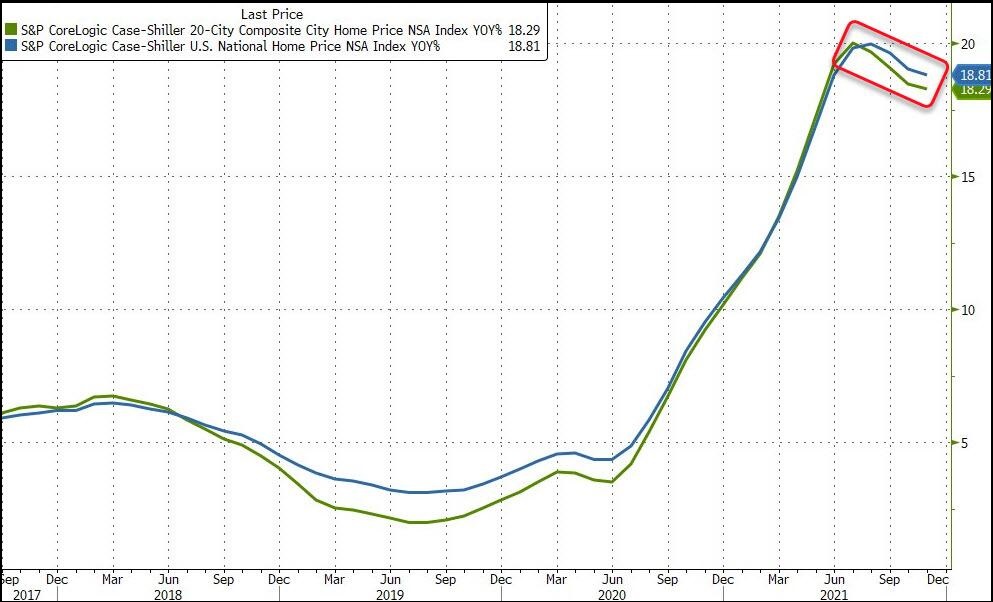Working Class Americans Expect Higher Inflation, Fed Announces March Rate Hike, Economy in Quagmire
A Gallup news survey [DATA HERE] indicates that eight out of ten Americans expect higher prices and continued rising inflation, as the working class can see the through the smoke and mirrors of the Biden economy.
 Overall, there are multiple datapoints that show the economic quagmire that is taking place right now. Gasoline continues to rise in price, as oil costs continue to skyrocket as an outcome of Biden energy policy. Food store prices have only just begun to show the higher prices that are built into the replenishment process.
Overall, there are multiple datapoints that show the economic quagmire that is taking place right now. Gasoline continues to rise in price, as oil costs continue to skyrocket as an outcome of Biden energy policy. Food store prices have only just begun to show the higher prices that are built into the replenishment process.
Newly arriving goods overall are at a much higher price that previous inventory. The 30, 60 and 90-day terms of purchase order fulfillment are now reflecting the cumulative cost increases at every stage in the supply chain. Inbound prices to retail are still climbing. This is an economic quagmire created by inflation that cannot be avoided.
Fuel, food, home energy and home prices overall are rising. As a result, durable good spending has contracted. CTH has pointed out this dynamic for almost five months; however, the actual data is difficult to extract, because the scale of government spending in 2021 has clouded all of the economic indicators.
The official government inflation statistics at 7 to 9% do not accurately reflect the real inflation being felt by consumers, which is in the 25 to 40 percent range for highly consumable products. If you look around your local community, it is not difficult to see that working class Americans have modified all of their spending priorities to deal with the food, energy and housing inflation that cannot be avoided.
Inventories are climbing. [Article] The pundits claim inventories are building as supply chain issues are resolving. However, that’s not the real story. Inventories are climbing, productivity is dropping, and the Purchasing Manufacturers Index (PMI) is showing deceleration in manufacturing outputs.
An interesting backward looking graphic from Zero Hedge identified something CTH readers may remember discussing last year. We observed a significant skew inside the machinery of the economy that was created by the massive covid spending bill in early 2021.
The scale of appreciation in the value of homes in the real estate sector seemed to peak in the last two weeks of May and first two weeks of June 2021. From that point appreciation continued, but the rate of appreciation was dropping. Something shifted.

This declining rate of appreciation coincided with the shift in massive investor driven purchases in real estate.
The big hedge funds and financial portfolios started buying homes, and this dynamic created an artificial appreciation rate outside the Main Street worker home-buying dynamic.
Home value increases were not driven by working class families buying homes or moving up. Instead -on a macro level- home values effective mid-2021 were driven by institutional investors shifting to holding real estate assets instead of tenuously more risky paper.
The bottom line is this. Despite the indicators, which have been made useless by massive amounts of money pumped into the economy, we have been in a contracting economic position since mid-2021.
This is a very important aspect to accept when you are thinking about your current financial position, and/or what you may need to do going forward.
If you recognize the absence of real economic activity surfaced mid-2021; and if you accept that absence was hidden by economic activity generated by the spending of government funds injected into the economy; then you can better predict the depth of the hole that was covered up by government intervention.
Accepting that reality then the irreconcilable data starts to make things make sense:
♦ November 2021 retail employment hiring was down. Why? This should have been the pre-holiday hiring spree. However, retailers saw something in their brick and mortar sales that stopped them from hiring.
♦ The third quarter U.S. productivity (June, July, August) was down 5%. Why? If everyone was spending their COVID stimulus, why wasn’t manufacturing making more stuff? The reality was that wholesalers were clearing out product inventories as they knew inbound replacements would cost more…. so, they replaced less.
♦ Inflation wasn’t “transitory”? Why? Because the inflation was driven by the perfect storm of energy policy, monetary policy and government spending.
♦ December 2021, retail sales were lower than December 2020. Why? Because people bought less stuff, because people had less disposable income, because food, fuel, energy, home heating and home living costs were chewing up our paychecks and savings.
♦ The U.S. savings rate started rapidly declining. Why? Inflation.
♦ In the third and fourth quarter 2021, U.S. workers started quitting more (JOLT’s report). Why? A combination of vaccine mandate (minor cause) and people jumping jobs to get higher wages because inflation was crushing them (major cause).
The people predicting more inflation all the way through 2022 are correct. We have only just recently seen the first wave of 2022 product inflation hitting the supermarket in the past two weeks. There will be more waves as the prices embedded inside the cumulative supply chain have yet to surface.
However, stop and think about this overall economic situation, a real quagmire, as identified by the simple datapoints above. The professional political class and financial pundits will never admit the Main Street economy started contracting in the middle of 2021. From their perspective, the money pumped into the system was real. It wasn’t. It was all artificial economic stimulus.
Now, into this very specific -and never before experienced- economic quagmire, where we are supposed to pretend not to know things, the Federal Reserve is about to raise interest rates.
WASHINGTON (AP) — The Federal Reserve said Wednesday that it will “soon” be time to start raising interest rates, a key step in reversing pandemic-era policies that have fueled hiring and growth but also high inflation.
The Fed is expected to lift its benchmark short-term rate from zero as soon as March, when it also plans to phase out monthly bond purchases that have been intended to anchor longer-term rates.
Chair Jerome Powell said at a news conference that these actions will help prevent high inflation from becoming entrenched and that the central bank can manage the process in a way that prolongs economic growth and keeps unemployment low. (more)
As I have just outlined above, the “economic growth” they cite is not real. The ‘economic growth‘ was created by government spending.
The government spending has stopped. The cover over the hole is being removed, and the Fed is raising interest rates.
What do you think is about to happen?
FUBAR.
When I am wrong, stop listening to me. In the interim, prepare your family accordingly.





Post a Comment